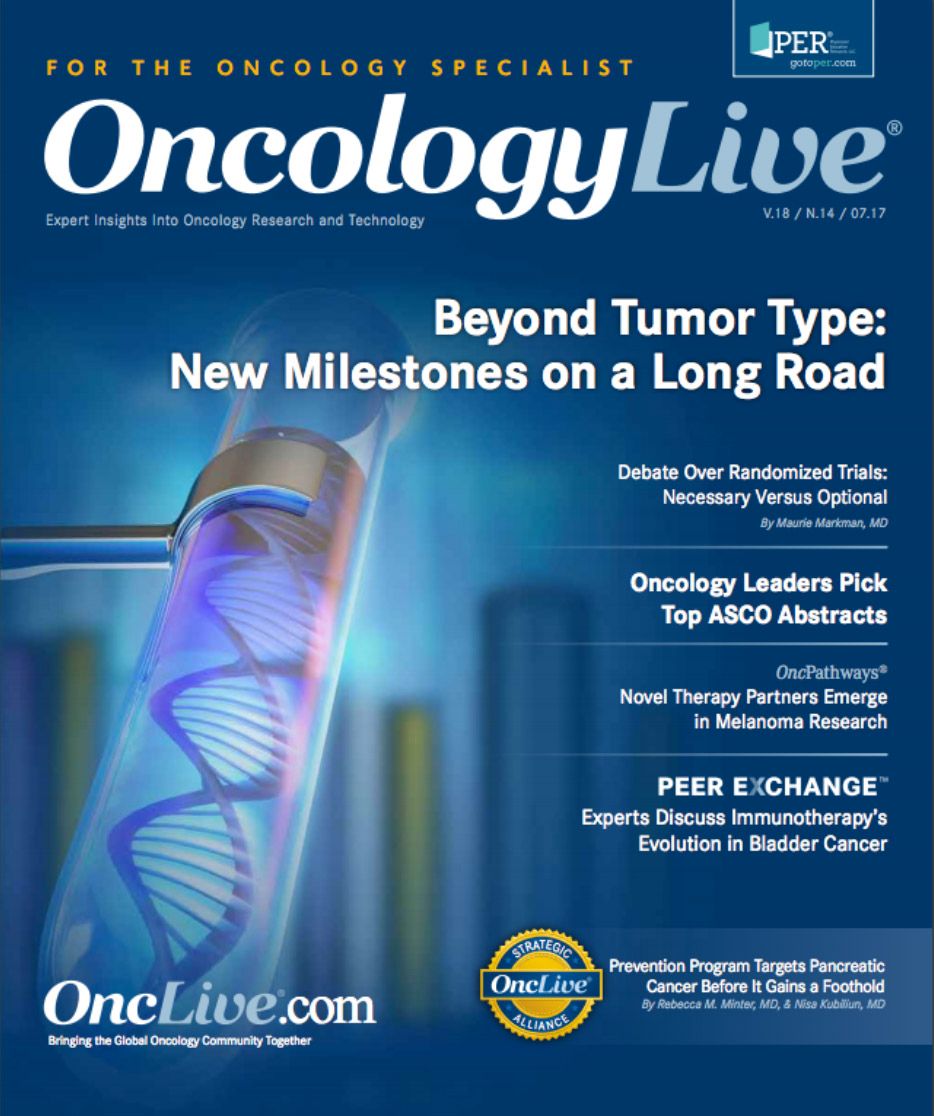TRK Inhibitors Advance Rapidly in "Tumor-Agnostic" Paradigm
The growing use of next-generation sequencing has only recently revealed the neurotrophic tropomyosin receptor kinase (NTRK) gene presence across a wide range of tumor types and piqued interest in their potential as anticancer targets.
DNA

Although oncogenic fusions involving the neurotrophic tropomyosin receptor kinase (NTRK) genes were first noted more than 30 years ago, the growing use of next-generation sequencing has only recently revealed their presence across a wide range of tumor types and piqued interest in their potential as anticancer targets.
Just as ALK inhibitors developed quickly as a lung cancer treatment, drugs targeted at the tropomyosin receptor kinase (TRK) protein family, encoded by the NTRK genes, are following a rapid bench-to-bedside trajectory. The FDA has granted breakthrough therapy designations to entrectinib and larotrectinib (LOXO-101) for patients with metastatic NTRK fusion—positive solid tumor types, and several other agents are being tested in clinical trials (Table).
Meanwhile, the development of acquired resistance is already being addressed by the advancement into clinical testing of secondgeneration agents with efficacy in resistant tumors, even before the first generation has received FDA approval.
The TRK Pathway
Most intriguingly, the low prevalence of NTRK fusions in individual tumor types has necessitated the use of novel clinical trial designs, such as basket trials. The astonishing efficacy of TRK inhibitors in NTRK fusion—positive patients, regardless of histology, exemplifies the potential of the “tumor-agnostic” treatment paradigm.In the mid-1980s, an oncogenic fusion of the TPM3- NTRK1 genes, observed in a colon tumor sample, was among the first chromosomal rearrangements identified in cancer.1 Since then, this type of molecular abnormality has been widely recognized as a driving event in a broad array of tumor types2, and the development of drugs designed to target such aberrations has greatly improved outcomes in some forms of cancer.
NTRK1 encodes the TRK A protein that, together with TRK B and C (encoded by the NTRK2 and NTRK3 genes, respectively), form the TRK family of proteins. These receptors conduct signaling pathways that play a key role in the development of the central and peripheral nervous systems.
TRK signaling is activated by the binding of neurotrophin ligands, predominantly nerve growth factor (NGF), brain-derived neurotrophic factor (BDNF), and neurotrophin-3 (NT-3); they bind, respectively, to TRK A, B, and C (Figure).3-5 As with other tyrosine kinase receptor—driven pathways, ligands bind to the part of the receptor that extends out of the cell. This causes 2 receptor molecules to pair up, driving phosphorylation of critical tyrosine residues on the portion of the receptor that protrudes into the cell and creating docking sites for intracellular proteins that contain specific domains.
TRK Signaling Pathways3-5
Role of Gene Fusions
In this manner, the signal is transduced inside the cell and subsequently propagated further downstream as the recruited adaptor proteins turn on other pathways, including PI3K, MAPK, and PLCγ. Ultimately, the signal reaches the nucleus, initiating a variety of transcriptional programs that mediate cellular outcomes, in this case regulating the proliferation, growth, and survival of neurons.Since the early reports of the TPM3-NTRK1 fusion, a variety of NTRK gene abnormalities have been described in different tumor types, including amplifications, deletions, mutations, and altered splicing of TRK messenger RNA (mRNA) transcripts. Few of these abnormalities have been functionally characterized, and even fewer have been proven to be oncogenic, with the exception of an in-frame deletion and mRNA splice variant in acute myeloid leukemia and neuroblastoma, respectively.
The best-characterized oncogenic role is for chromosomal rearrangements involving the NTRK genes. Most commonly, these rearrangements result in gene fusions in which the NTRK gene is broken apart, and the portion containing the kinase domain is fused back together next to a different gene, causing the TRK protein to become activated even in the absence of its ligand. This promotes cancer formation by driving several of the cancer hallmarks, including unchecked cell proliferation and growth, through the TRK pathway.
The development of next-generation sequencing technologies has greatly expanded appreciation of the role of NTRK fusions in the development of cancer. To date, multiple fusion partners that play oncogenic roles across 19 tumor types have been identified for all 3 NTRK genes.3-5
Targeted Therapies Emerge
In the more common types of cancer, such as lung, colorectal, and head and neck cancers, NTRK fusions occur at a low frequency, but they represent the dominant driver in certain rarer types. For example, the ETV6-NTRK3 gene fusion is found in all cases of mammary analog secretory carcinoma (MASC) and in 93% of secretory breast cancers6,7; NTRK gene fusions are found in up to half of all pediatric patients with diffuse intrinsic pontine glioma and non-brainstem glioblastoma.8Numerous multikinase inhibitors already on the market or in clinical development have been shown to inhibit the TRK kinases to some extent, but they have not yet been tested specifically in patients with NTRK fusions.
Entrectinib and larotrectinib represent the first of a growing number of oral small-molecule inhibitors with potent activity against all 3 TRK proteins. Entrectinib also targets the ALK and ROS1 kinases, while larotrectinib is the first drug in clinical development that selectively inhibits the TRK proteins alone.9,10
Both front-runner drugs have shown potent clinical activity in patients with metastatic or unresectable solid tumors, most promisingly in patients harboring NTRK fusions. As a result, researchers have begun to limit clinical trial enrollment to patients whose tumors harbor these alterations, revealed through biomarker analysis.
Another notable feature of entrectinib is its ability to cross the blood-brain barrier, which could make it more effective in patients with primary brain tumors or brain metastases. Larotrectinib may also be able to penetrate the blood-brain barrier, though to a much lesser extent.9,10
Entrectinib Studies
Entrectinib has been evaluated in 2 phase I studies: ALKA-372-001, with 54 patients, and STARTRK-1, with 65 patients. Both studies enrolled participants with a range of solid tumor types, including primary brain, head and neck, breast, renal cell, ovarian, sarcoma, and melanoma; however, 60% of the participants had non—small cell lung cancer (NSCLC).
Approximately half of the patients enrolled had an NTRK, a ROS1, or an ALK gene fusion; responses across both studies were limited to 25 patients with mutations who had not previously been treated with a tyrosine kinase inhibitor. Among 3 participants with NTRK fusions, the response rate was 100%, with the most durable response of over 15 months observed in a patient with colorectal cancer with an LMNA-NTRK1 fusion. Another patient with a glioneuronal tumor with a BCANNTRK1 fusion experienced stable disease and, according to 3-dimensional volumetric assessment, the tumor burden was reduced by 60%.9,11
Entrectinib was well tolerated in phase I trials, with fatigue, dysgeusia, paresthesia, nausea, and myalgia the most commonly observed adverse events (AEs). Based on the positive data from these trials, the FDA awarded entrectinib a breakthrough therapy designation in May and it is being evaluated in the phase II STARTRK-2 study at a dose of 600 mg daily.
Larotrectinib Trials
Findings regarding larotrectinib created a significant buzz at the American Society of Clinical Oncology (ASCO) Annual Meeting in June. The data came from an integrated analysis of ongoing phase I/II studies involving 55 participants, including 12 pediatric and 43 adult patients, with 17 unique cancer types. They received larotrectinib primarily at a dose of 100 mg twice daily on a continuous 8-day schedule.
The overall response rate, based on investigator assessment for 50 patients for whom confirmatory data were available, was 76% (95% CI, 0.62-0.87), including a partial response in 64% of patients and a complete response in 12%. The 5 patients who joined the study too early for confirmatory scans had at least a partial response to larotrectinib.12
In a separate analysis of 17 pediatric patients with heterogenous tumor types, also presented at ASCO, responses were seen exclusively in those with NTRK gene fusions. The majority of NTRKpositive patients experienced confirmed responses regardless of tumor type, and the drug was well tolerated, with an AE profile that included vomiting, nausea, and fatigue.13
Additional Prospects
At least 6 additional drugs that target the TRK pathway are in clinical development (Table). Early results from an ongoing first-in-human trial have been reported for DS-6051b, which inhibits TRK A, B, and C, in addition to ROS1. At the time of analysis, 22 patients with tumor types including neuroendocrine carcinoma and NSCLC had been enrolled and were being treated with once-daily doses of 50, 100, 200, 400, 800, or 1200 mg.14
Table. TRK inhibitors in Clinical Development
Two dose-limiting toxicities occurred at the highest dose, both involving grade 3 transaminase elevations. The maximum tolerated dose was 800 mg once daily. Two patients showed partial responses; notably, 1 of these patients had progressed on both crizotinib and ceritinib. The most frequent treatment-related AEs were diarrhea, nausea, vomiting, dehydration, dizziness, dysgeusia, and fatigue.
Additionally, several FDA-approved drugs inhibit TRK proteins along with cell signaling pathways for which they are better known. Cabozantinib (Cabometyx; Cometriq), a small-molecule inhibitor of multiple receptor tyrosine kinases, targets TRK B along with MET, RET, VEGFR, and FLT3. It is in clinical development for NTRK fusion—positive NSCLC (NCT01639508).
“Tumor-Agnostic” Approach
Other multikinase inhibitors with the potential to target TRK include the FDA-approved drugs regorafenib (Stivarga), crizotinib (Xalkori), and midostaurin (Rydapt).4 Thus far, clinical trials employing these drugs in NTRK fusion-positive cancers have not been announced.In addition to their promising clinical activity, entrectinib and larotrectinib are noteworthy because of the “tumor agnostic” manner in which they are being developed. Patients are enrolled into clinical trials based on whether their cancer exhibits the biomarker target under study rather than a particular tumor type. Some of the studies have employed basket trial designs that have been growing in popularity as a way to better identify reliable molecular biomarkers that can predict therapeutic response to a drug across tumors with diverse histologic backgrounds.
Despite the inherent challenges associated with the rarity of NTRK fusions, the data emerging from the development of TRK inhibitors support widespread genetic testing for these genomic abnormalities. The novel paradigms being used for the development of TRK inhibitors could make them the most rapid bench-to-bedside success story in the history of targeted therapies.
Staying 1 Step Ahead
Based on the striking data presented at ASCO, Loxo Oncology plans to submit a new drug application to the FDA in late 2017 or early 2018.15 If approved, LOXO-101 would follow in the footsteps of pembrolizumab (Keytruda) as the latest option in a new generation of cancer-agnostic drugs for patients with a specific molecular biomarker. Pembrolizumab was recently approved for the treatment of patients with microsatellite instability or mismatch repair defects regardless of tumor type.The success of kinase inhibitors for treating diverse cancer types has been overshadowed by the development of resistance and TRK inhibitors appear to face the same issue; the duration of response to entrectinib and larotrectinib is likely to be limited by acquired resistance.
Several studies have detailed the acquisition of secondary mutations in the TRK kinase domain following treatment with a TRK inhibitor, similar to the mechanisms of resistance reported for other kinase inhibitors.
Specifically, they include the G595R, G677C, and G623R substitutions that affect the solvent front (so-called because of its biochemical properties) and the xDFG motifs of the kinase domain. These mutations have subsequently been shown to render cancer cells resistant to all TRK inhibitors currently in clinical development.11,12,16,17
Learning from past experience, Loxo Oncology is seeking to stay 1 step ahead of the game with a next-generation TRK inhibitor, LOXO-195. A recently published report on the preclinical development of LOXO-195 included data from the first 2 patients treated after developing resistance to larotrectinib.
Both patients experienced a rapid response to LOXO-195. The first patient, an adult with LMNANTRK1 fusion-positive colorectal cancer had a 58% reduction in tumor burden and remains on treatment after more than 6 months. The second patient, a 2-year old with ETV6-NTRK3 fusion—positive infantile fibrosarcoma, was treated for 3 months. She experienced a partial response, with tumor regression of at least 30%, but eventually succumbed to her disease.18
Historically, there has been a significant delay in the development of second-generation drugs, as characterization of the mechanisms of resistance and the subsequent development of drugs to overcome them usually followed FDA approval and substantial clinical experience with the first generation. In this case, researchers already anticipate widespread resistance, and the development of the next generation of TRK inhibitors is occurring simultaneously
References
- Martin-Zanca D, Hughes SH, Barbacid M. A human oncogene formed by the fusion of truncated tropomyosin and protein tyrosine kinase sequences. Nature. 1986;319(6056):743-748. doi: 10.1038/319743a0.
- Mitelman F, Johansson B, Mertens F. The impact of translocations and gene fusions on cancer causation. Nat Rev Cancer. 2007;7(4):233-245. doi: 10.1038/nrc2091.
- Amatu A, Sartore-Bianchi A, Siena S. NTRK gene fusions as novel targets of cancer therapy across multiple tumour types. ESMO Open. 2016;1(2):e000023. doi: 10.1136/esmoopen-2015-000023.
- Khotskaya YB, Holla VR, Farago AF, Mills Shaw KR, Meric-Bernstam F, Hong DS. Targeting TRK family proteins in cancer. Pharmacol Ther. 2017;173:58-66. doi: 10.1016/j.pharmthera.2017.02.006.
- Vaishnavi A, Le AT, Doebele RC. TRKing down an old oncogene in a new era of targeted therapy. Cancer Discov. 2015;5(1):25-34. doi: 10.1158/2159-8290.CD-14-0765.
- Bishop JA, Yonescu R, Batista D, Begum S, Eisele DW, Westra WH. Utility of mammaglobin immunohistochemistry as a proxy marker for the ETV6-NTRK3 translocation in the diagnosis of salivary mammary analogue secretory carcinoma. Hum Pathol. 2013;44(10):1982-1988. doi: 10.1016/j.humpath.2013.03.017.
- Tognon C, Knezevich SR, Huntsman D, et al. Expression of the ETV6-NTRK3 gene fusion as a primary event in human secretory breast carcinoma. Cancer Cell. 2002;2(5):367-376. doi: 10.1016/S1535-6108(02)00180-0.
- Wu G, Diaz AK, Paugh BS, et al. The genomic landscape of diffuse intrinsic pontine glioma and pediatric non-brainstem high-grade glioma. Nat Genet. 2014;46(5):444-450. doi: 10.1038/ng.2938.
- Rolfo C, Ruiz R, Giovannetti E, et al. Entrectinib: a potent new TRK, ROS1, and ALK inhibitor. Expert Opin Investig Drugs. 2015;24(11):1493-1500. doi: 10.1517/13543784.2015.1096344.
- TRK inhibitor shows early promise. Cancer Discov. 2016;6(1):OF4. doi: 10.1158/2159-8290.CD-NB2015-165.
- Drilon A, Siena S, Ou SI, et al. Safety and antitumor activity of the multitargeted pan-TRK, ROS1, and ALK inhibitor entrectinib: combined results from two phase I trials (ALKA-372-001 and STARTRK-1). Cancer Discov. 2017;7(4):400-409. doi: 10.1158/2159-8290.CD-16-1237
- Hyman DM, Laetsch TW, Kummar S, et al. The efficacy of larotrectinib (LOXO-101), a selective tropomyosin receptor kinase (TRK) inhibitor, in adult and pediatric TRK fusion cancers [ASCO abstract LBA2501]. J Clin Oncol. 2017;35(suppl). abstracts.asco.org/199/AbstView_199_195112.html.
- Laetsch TW, DuBois SG, Nagasubramanian R, et al. A pediatric phase I study of larotrectinib, a highly selective inhibitor of the tropomyosin receptor kinase (TRK) family [ASCO abstract 10510]. J Clin Oncol. 2017;35(suppl). abstracts.asco.org/199/AbstView_199_183181.html
- Papadopoulos KP, Borazanci E, Von Hoff D, et al. First-in-human phase 1 dose-escalation study of DS-6051b, an oral ROS1 and NTRK inhibitor, in subjects with advanced solid tumors [AACR abstract CT024]. Cancer Res. 2016;76(suppl 14). doi: 10.1158/1538-7445.AM2016-CT024.
- Loxo Oncology breakthrough therapy larotrectinib demonstrates 76 percent confirmed objective response rate in TRK fusion adult and pediatric cancers as presented at the American Society of Clinical Oncology [news release]. Stamford, CT; Loxo Oncology, Inc; June 3, 2017. ir.loxooncology.com/press-releases/loxo-oncology-breakthrough-therapy-larotrectinib-demonstrates-76-percent-confirmed-objective-response-rate-in-trk-fusion-adult-and-pediatric-cancers-as-presented-at-the-american-society-of-clinical-on. Accessed July 23, 2017.
- Drilon A, Li G, Dogan S, et al. What hides behind the MASC: clinical response and acquired resistance to entrectinib after ETV6-NTRK3 identification in a mammary analogue secretory carcinoma (MASC). Ann Oncol. 2016;27(5):920-926. doi: 10.1093/annonc/mdw042.
- Russo M, Misale S, Wei G, et al. Acquired resistance to the TRK inhibitor entrectinib in colorectal cancer. Cancer Discov. 2016;6(1):36-44. doi: 10.1158/2159-8290.CD-15-0940.
- Drilon A, Nagasubramanian R, Blake JF, et al. A next-generation TRK kinase inhibitor overcomes acquired resistance to prior TRK kinase inhibition in patients with TRK fusion-positive solid tumors [published online June 3, 2017]. Cancer Discov. doi: 10.1158/2159-8290.CD-17-0507




